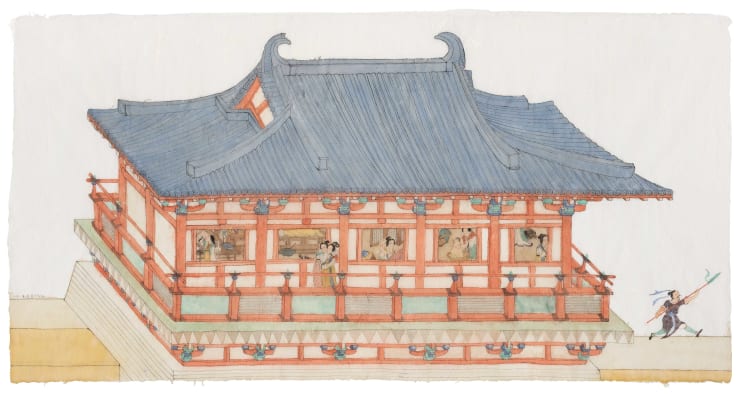Memory Palace: Peng Wei solo exhibition
-
-
Overview
Peng Wei: Memory Palace
Exhibition Dates│05.25.2024–07.13.2024
Reception|05.25.2024 (Sat.) 4:30 p.m.
Venue │ Tina Keng Gallery (1F, No. 15, Ln. 548, Ruiguang Rd., Neihu Dist., Taipei, Taiwan 114)
Memory Palace, Peng Wei’s solo exhibition at Tina Keng Gallery, attests to the journey on which the artist has embarked. Consisting of nearly 50 paintings and nine video works, the exhibition tells an elaborate story through several series, from “A Large Room,” “A Room with a Story,” “Corridor,” “Pagoda,” “Peek,” “Song of Songs,” “Crown,” to video series “We All Need Stories.” The exhibition title betokens the palace Peng has conjured and centered on women, where she gently weaves memories from a female perspective into intricate, layered narratives, allowing the viewer to follow, either stop and gaze, or have something quietly seared in their mind.
-
-
How do we create memory? In 1582, Jesuit missionary Matteo Ricci arrived in China. In addition to his missionary work, Ricci was devoted to promoting his method of memory training: the Memory Palace[1]. He proposed three methods of creating mental palaces to aid memory: the first is a real space based on the real world, the second a fictional dwelling, and the third, an amalgamation, a memory palace that straddles reality and imagination.
This training aims to construct a comprehensive storage space for knowledge. By assigning vivid images to things and placing them in specific locations, we can accurately retrieve the correct knowledge and memories through rules or associations. The concept of the memory palace was not invented by Ricci. It can be traced back to the application of memory training advocated by the ancient Greek poet Simonides of Ceos. The memory palace is not merely a methodological theory. It also involves the human emotional experience of past memories and emotions, the empathetic experiences that blend with the real world, and how we cohabit, interpret, and enter a dialogue with these myriad fragments of memories.
Memory Palace, Peng Wei’s solo exhibition at Tina Keng Gallery, attests to the journey on which the artist has embarked. Consisting of nearly 50 paintings and nine video works, the exhibition tells an elaborate story through several series, from “A Large Room,” “A Room with a Story,” “Corridor,” “Pagoda,” “Peek,” “Song of Songs,” “Crown,” to video series “We All Need Stories.” The exhibition title betokens the palace Peng has conjured and centered on women, where she gently weaves memories from a female perspective into intricate, layered narratives, allowing the viewer to follow, either stop and gaze, or have something quietly seared in their mind.
Series such as “A Large Room,” “A Room with a Story,” “Corridor,” and “Pagoda” often draw inspiration from ancient myths, Chinese festivals, and everyday conversations with friends. Incorporating the architecture depicted in the Dunhuang murals — windows, rooms, corridors, and pagodas, the artist interweaves painting and the animated image to create a magical yet realistic feminine space where she delves into issues of gender and historical cultural identity.
Beginning in 2016, the “Song of Songs” series is inspired by the symbolic imagery of ancient painting. The artist takes the figures out of their past context, and infuses them with a contemporary spirit. Rendered on transparent paper, the figures materialize in bold, modest strokes against an expanse of white space. Standing, sitting, or reclining, the characters invite interpretation with their gestures and facial expressions. With this series, Peng Wei poses a question: What is real and what is illusory when it comes to memory? Painted on scrap paper from the artist’s studio, the “Once Again” series instantiates remnants of the past. Old marks are concealed under new brushstrokes that coalesce into new narratives imbued with significance and dual memories.
Revolving around the female perspective, love can be portrayed in myriad ways. The series “A Room with a Story” aims to illustrate different characters in different spaces with their own thoughts and musings. The “Crown” series can be seen as the end, or the beginning, of Memory Place. The hat or crown painted in color and ink encapsulates crystallized memory, while alluding to the way we rummage through recollections.
Memory Palace is a chronicle of Peng Wei’s artistic journey from 2016 to 2024. As a seminal contemporary artist in present-day China, she has never intended her work to be didactic or moralizing. Instead, she paints through delicate brushwork a vivid portrayal of life, emotion, and fantasy seen through the eyes of a contemporary Chinese woman, meditating life in all its vicissitudes.
[1] Spence, Jonathan D., The Memory Palace of Matteo Ricci (Taipei: Reading Times, 2023.)
-
Works
-
 彭薇 Peng Wei, 塔 No. 9 Pagoda No. 9, 2021
彭薇 Peng Wei, 塔 No. 9 Pagoda No. 9, 2021 -
 彭薇 Peng Wei, 有故事的房間 No. 18 A Room with a Story No. 18, 2021
彭薇 Peng Wei, 有故事的房間 No. 18 A Room with a Story No. 18, 2021 -
 彭薇 Peng Wei, 迴廊 No. 2 Corridor No. 2, 2022
彭薇 Peng Wei, 迴廊 No. 2 Corridor No. 2, 2022 -
 彭薇 Peng Wei, 窺 No. 32 Peek No. 32, 2019
彭薇 Peng Wei, 窺 No. 32 Peek No. 32, 2019 -
 彭薇 Peng Wei, 雅謌 No. 25 - 棋會 1、2、3 Song of Songs No. 25 - Chess Game 1, 2, 3, 2023
彭薇 Peng Wei, 雅謌 No. 25 - 棋會 1、2、3 Song of Songs No. 25 - Chess Game 1, 2, 3, 2023 -
 彭薇 Peng Wei, 冠 No. 2 Crown No. 2, 2024
彭薇 Peng Wei, 冠 No. 2 Crown No. 2, 2024
-










